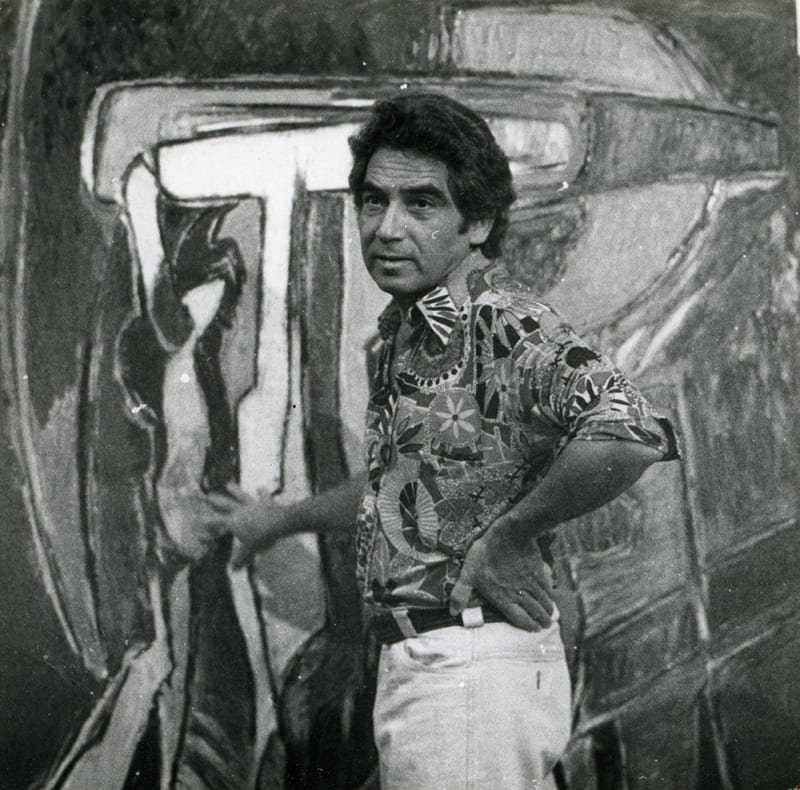Kwai Fung Hin Art Gallery is delighted to represent the works of Oswaldo Vigas (Valencia, Venezuela, 1923 — Caracas, Venezuela, 2014), one of Latin America's most prominent avant-garde artists, in Asia on an exclusive basis, pursuant to a collaboration with Fundación Oswaldo Vigas. Major works of the artist will be presented by the gallery at the coming Art Basel Hong Kong 2023. Vigas actively helped to shape the cultural life of his country and played a key role in the Parisian art scene between 1952 and 1964.
ABOUT THE ARTIST
Profusely inspired by the origin of life, the Latin American landscape, its history and mythology, Vigas’s work is rooted in a number of styles, such as Constructivism, Informalism and Neo-figuration, all applied in a personal way. Prompted by a search for his mestizo identity, Vigas remained faithful to his own convictions, which led to an authentic artistic imagery. He was the first Venezuelan artist to draw on the country’s forgotten pre-Columbian and African cultural patrimony, interweaving it with European and American modernism.
Vigas's body of work encompasses painting, sculpture, printmaking, ceramics, and tapestries. He has been recognized with over one hundred solo exhibitions, and his work is represented in numerous institutional and private collections.
ARTISTIC STYLE
EARLY WORKS (1942 – 1952)
From a very young age, Vigas was attracted by the cultural origins of Latin America. As a young artist he traveled in search of signs that revealed the most authentic and primitive aspects of his country. He filled his notebook with images of petroglyphs, pre-Columbian ornaments, and facial paintings of the Guajira culture—a quest that would determine the direction of his work. Through these touchpoints, the artist strengthened the thematic constants that inform his highly individual iconography. The pre-Columbian, in particular, motivated him to deepen his symbolic language, expressed through the figures and graphics that appear in his paintings.
GEOMETRY AND CONSTRUCTIVISM (1953 – 1958)
During the first part of his Parisian years, 1953 to 1958, Vigas began to adapt what he needed to tie into his own visual vocabulary, incorporating Constructivism and geometry into American and pre-Columbian imagery while maintaining an organic feel for abstraction. As he began to produce more linearly structured works, an innovative synthesis of forms flourished, several of which he realized as monumental murals at the University City of Caracas, a World Heritage site.
INFORMALISM AND CALLIGRAPHY (1959 – 1964)
At the end of the 1950s and beginning of the ‘60s Vigas liberated his artistic practice from a reliance on abstraction and focused on the driving force of emotions, the substance of his materials, and the very act of painting. Texture, movement, and gesture allowed Vigas to engage with some of the very forces that were said to be driving abstractionism: chiefly, the primal, the spiritual, and the metaphysical. Though venturing often beyond figuration, Vigas did not detach himself completely from figures, and still frequently emulated animals and other beasts, as Informalism and Expressionism took hold of his imagination and set the course for the next decade of his work.
RETURN TO THE HOMELAND – THE NEW FIGURATION (1965 – 2014)
After living and working in Paris for twelve years, Vigas returned to Venezuela in 1964. His homecoming, which followed the rich and varied experiences of Paris, marked the arrival of what art critics term Vigas’s neo-figurative period, in which beastlike figures of women and other totems haunt his canvases.
The works from 1969 to 1973 returned to a visual poetry tending toward geometric abstraction, which Vigas called “the geometry of sensitivity.” Vigas’s phrase is particularly striking because two opposite ideas are juxtaposed with each other. On one hand, there is the organization of geometry as a map of rationality that makes reality understandable, according to the conceptual blueprint he provides. Sensitivity, on the other hand, comes from affective territory: the delicate space of perception and the realm of the feelings, and the passion for life and its questions.
Since the 1990s until the second decade of the 2000s, Vigas continued to paint women and ghostly beings, in conjunction with nature and its organic vitality. He worked with sketches, from which he transferred the figures to canvas. The results are paintings made with courage and a similar energy to the wild instinct of nature, the transformer of bodies and generator of life.
IMPORTANT EXHIBITIONS AND NOTABLE COLLECTIONS
Exhibitions
The Museum of Fine Arts, Houston, USA (1956, 2018-2019)
The Musée de la Monnaie, Paris, France (1993)
Musée d'Art Moderne de la Ville de Paris, Paris, France (1962)
Salon de Mai, Paris, France (1953, 1954, 1955, 1956, 1957, 1962)
Dallas Museum of Fine Arts, Texas, USA (1959)
Carnegie Institute, Pittsburg, USA (1958)
III Bienal do Museu de Arte Moderna de São Paulo (1955)
La Biennale di Venezia, Venice, Italy (1954, 1962)
Collections
Art Museum of the Americas, Washington, D.C., USA
AVON, New York, USA
Grand Rapids Art Museum, Michigan, USA
Michigan State University Broad Art Museum, East Lansing, USA
Museum of Fine Arts Houston, Texas, USA
Musée d'art contemporain du Val-de-Marne, France
Musée des Beaux Arts d’Angers, France
Villa Tamaris Centre d'Art, La Seyne-sur-Mer, France
Galería de Arte Nacional, Caracas, Venezuela
Museo de Arte Contemporáneo, Lima, Peru
Museo Nacional de Bellas Artes, Santiago, Chile
